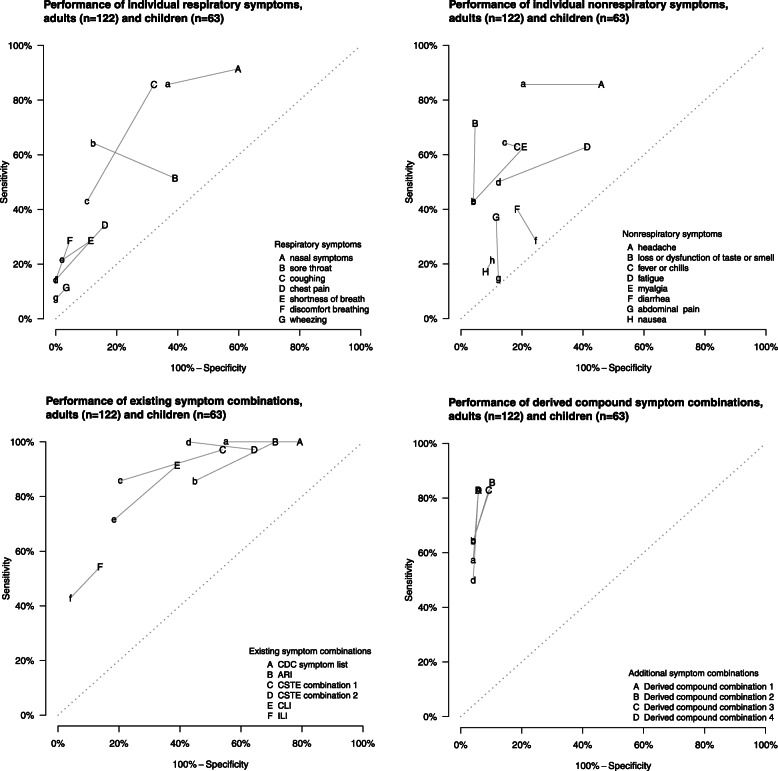Fig. 2.
Sensitivity and 100%-specificity for individual COVID-19 symptoms, existing case definitions, and derived compound symptom combinations for a community cohort of 122 adults (upper case letters) and 63 children (lower case letters) with household exposure to COVID-19 in Utah and Wisconsin, United States, March–May 2020. Specificity is the probability of testing negative when disease is absent. Sensitivity is the probability of testing positive when disease is present. CDC symptom list=U.S. Centers for Disease Control and Prevention (CDC) list of symptoms that may indicate COVID-19 infection (https://www.cdc.gov/coronavirus/2019-ncov/symptoms-testing/symptoms.html). This symptom list was last updated on 13 May 2020. ARI=World Health Organization (WHO) acute respiratory infection (ARI) definition for community-based respiratory syncytial virus (RSV) surveillance (https://www.who.int/influenza/rsv/rsv_case_definition/en/). Last updated 04 February 2020. CSTE combination 1=U.S. Council of State and Territorial Epidemiologists (CSTE) original clinical criteria for COVID-19 reporting (https://cdn.ymaws.com/www.cste.org/resource/resmgr/2020ps/interim-20-id-01_covid-19.pdf). This interim position statement (Interim-20-ID-01) was approved on 05 April 2020 and was replaced by Interim-20-ID-02 on 07 August 2020. CSTE combination 2=U.S. Council of State and Territorial Epidemiologists (CSTE) revised clinical criteria for COVID-19 reporting (https://cdn.ymaws.com/www.cste.org/resource/resmgr/ps/positionstatement2020/interim-20-id-02_COVID-19.pdf). This interim position statement (Interim-20-ID-02) was approved on 07 August 2020 and replaced Interim-20-ID-01. CLI=U.S. Centers for Disease Control and Prevention (CDC) COVID-19-like illness (CLI) definition was used to guide early diagnostic testing strategies from 17 January 2020–08 March 2020 (https://emergency.cdc.gov/han/han00426.asp). ILI=Influenza-like illness (ILI) outpatient visit information collected through the U.S. Outpatient Influenza-like Illness Surveillance Network (ILINet) (https://www.cdc.gov/flu/weekly/overview.htm#anchor_1539281266932). This collaborative effort between CDC, state and local health departments, and healthcare providers has been tracking patients with ILI since the 1997–1998 influenza season. Derived compound combination 1: Taste and/or smell dysfunction, OR one of the following: shortness of breath, myalgia, or fever or chills. Derived compound combination 2: Taste and/or smell dysfunction or discomfort breathing, OR at least two of the following: shortness of breath, wheezing, or fever/chills. Derived compound combination 3: Taste and/or smell dysfunction, OR at least two of the following: shortness of breath, wheezing, discomfort breathing, or fever/chills. Derived compound combination 4: Taste and/or smell dysfunction, OR shortness of breath and fever/chills. Points closest to the upper left corner represent those with the highest sensitivity and specificity values

